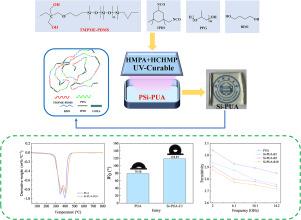用于高性能紫外光固化聚氨酯的丁基/醚端杂化聚硅氧烷:电子封装中的超低介电常数和超疏水性
IF 5.1
3区 工程技术
Q1 CHEMISTRY, APPLIED
引用次数: 0
摘要
为了解决传统聚氨酯(PU)在电子封装中的局限性(如疏水性、介电性能和热稳定性差),通过硅氢化反应合成了三种端部为丁基/醚杂化结构的聚硅氧烷(TMPME-PDMS, MNMR = 995-3318 g/mol),并将其化学接枝到端部为丙烯酸酯的PU上。用3 wt%的光引发剂(HMPA/HCHMP = 1:1)对所得硅改性聚氨酯丙烯酸酯(Si-PUAs)进行紫外光固化。相对于纯PUA,其疏水性和热稳定性显著增强,但介电性能降低。当TMPME-PDMS浓度为1 wt% (MNMR = 3318 g/mol)时,水接触角从原始PU的79.34°增加到118.09°。当加入10 wt%的TMPME-PDMS (MNMR = 2218 g/mol)时,软段分解温度(Tgs)提高到412.60℃,比未改性PU高19.20℃。在14.2 GHz时,10 wt%的TMPME-PDMS (MNMR = 3318 g/mol)将介电常数降低至2.67,比PU低6.32%。TMPME-PDMS的分子量(MNMR)和剂量对微相分离、交联密度和表面迁移有重要影响,从而实现可调性能。这项工作为先进电子封装中的高性能紫外光固化涂层提供了可扩展的策略。本文章由计算机程序翻译,如有差异,请以英文原文为准。

Butyl/ether hybrid-terminated polysiloxanes for high-performance UV-curable polyurethanes: Ultra-low dielectric constant and superhydrophobicity in electronic packaging
To address the limitations of conventional polyurethane (PU) in electronic packaging (e.g., poor hydrophobicity, dielectric properties, and thermal stability), three mono-dihydroxyalkyl-terminated polysiloxanes (TMPME-PDMS, MNMR = 995–3318 g/mol) featuring a butyl/ether hybrid terminal structure were synthesized via hydrosilylation and chemically grafted into acrylate-end-capped PU. The resulting silicone-modified polyurethane acrylates (Si-PUAs) were UV-cured with a 3 wt% photoinitiator (HMPA/HCHMP = 1:1). Relative to pure PUA, the hydrophobicity and thermal stability were significantly enhanced, together with reduced dielectric properties. With a mere 1 wt% TMPME-PDMS (MNMR = 3318 g/mol), the water contact angle was increased from 79.34° of pristine PU to 118.09°. When incorporating 10 wt% TMPME-PDMS (MNMR = 2218 g/mol), the soft-segment decomposition temperature (Tgs) was elevated to 412.60 °C, which was 19.20 °C higher than unmodified PU. At 14.2 GHz, 10 wt% TMPME-PDMS (MNMR = 3318 g/mol) reduced the dielectric constant to 2.67, 6.32 % lower than PU. The molecular weight (MNMR) and dosage of TMPME-PDMS critically governed microphase separation, crosslinking density, and surface migration, enabling tunable performance. This work provides a scalable strategy for high-performance UV-curable coatings in advanced electronics packaging.
求助全文
通过发布文献求助,成功后即可免费获取论文全文。
去求助
来源期刊

Reactive & Functional Polymers
工程技术-高分子科学
CiteScore
8.90
自引率
5.90%
发文量
259
审稿时长
27 days
期刊介绍:
Reactive & Functional Polymers provides a forum to disseminate original ideas, concepts and developments in the science and technology of polymers with functional groups, which impart specific chemical reactivity or physical, chemical, structural, biological, and pharmacological functionality. The scope covers organic polymers, acting for instance as reagents, catalysts, templates, ion-exchangers, selective sorbents, chelating or antimicrobial agents, drug carriers, sensors, membranes, and hydrogels. This also includes reactive cross-linkable prepolymers and high-performance thermosetting polymers, natural or degradable polymers, conducting polymers, and porous polymers.
Original research articles must contain thorough molecular and material characterization data on synthesis of the above polymers in combination with their applications. Applications include but are not limited to catalysis, water or effluent treatment, separations and recovery, electronics and information storage, energy conversion, encapsulation, or adhesion.
 求助内容:
求助内容: 应助结果提醒方式:
应助结果提醒方式:


